The Best Portable Chargers and Power Banks for Phones and Tablets
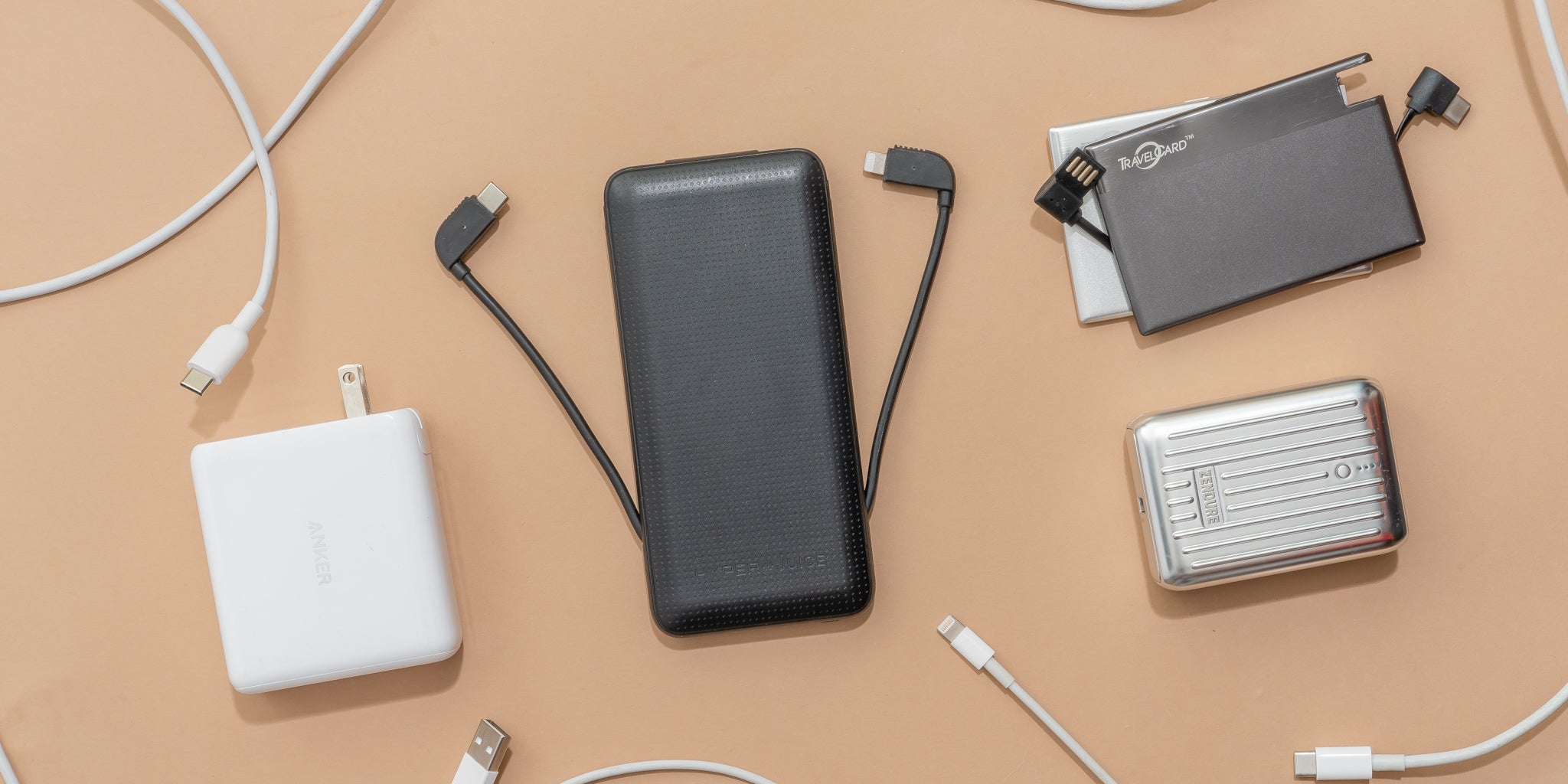
The Zendure SuperMini 20W is about as small and lightweight as a power bank can possibly be while still offering enough capacity to juice up most smartphones up to three times. Its USB-C Power Delivery (PD) port can charge most handheld devices (and recharge the power bank itself) at top speed with the included USB-C cable and a compatible wall charger (the one that came with your phone will work). The USB-A port can handle any older, non-USB-C devices you might have kicking around, too.
The SuperMini’s rounded edges make it easy to hold and slip into a pocket, and unlike most power banks, it comes in a wide range of colors: red, green, black, silver, blue, and pink.
Key specs
Rated capacity: 10,000 mAh (36 Wh)
Weight: 6.4 ounces
Tested input: 19.3 watts (USB-C PD port)
Tested output: 18.6 watts (USB-C PD port) and 16.6 watts (USB-A port)
This process left us with the following 23 power banks to test:
- Anker PowerCore 10000 PD Redux
- Anker PowerCore Fusion 5000
- Anker PowerCore Fusion 10000
- Anker PowerCore III Fusion 5K
- Anker PowerCore Slim 10000 PD
- Clutch V2 (Lightning) (discontinued)
- Clutch V2 (USB-C) (discontinued)
- Flux 4000 mAh Ultraslim Portable Charger
- HyperJuice 18W USB-C + Lightning Battery Pack (discontinued)
- HyperJuice 18W USB-C + Lightning Battery Pack (discontinued)
- Mophie Powerstation Hub
- Mophie Powerstation PD
- Mophie Powerstation Plus (USB-C)
- Mophie Powerstation Plus Mini (discontinued)
- Mophie Powerstation Plus Mini (USB-C)
- RAVPower 10000mAh Power Bank (RP-PB186)
- Real Graphene G-Lite (discontinued)
- TG90° Portable Charger 6000mAh External Battery Pack
- TravelCard Charger (discontinued)
- Tronsmart Trim 10000mAh USB-C Power Bank
- Zendure SuperMini 20W
- ZMI PowerPack 10K USB-C Power Bank (QB910)
- ZMI PowerPack Ambi 10K Dual USB-C Power Bank (discontinued)
Key specs
Rated capacity: 5,000 mAh (18 Wh)
Weight: 6.4 ounces
Tested input: 10.9 watts (built-in AC plug) and 18 watts (USB-C PD port)
Tested output: 18 watts (USB-C PD port), 13.5 watts (USB-A port when plugged in), and 12.5 watts (USB-A port when unplugged)
Everything we recommend
Our pick
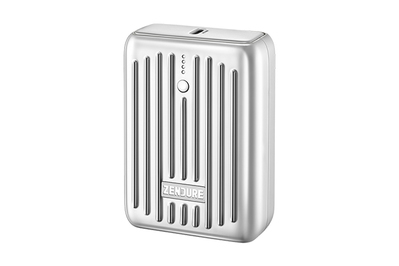
Zendure SuperMini 20W
The best power bank for phones, tablets, and more
This is the smallest and lightest 10,000 mAh power bank we’ve tested. It has USB-C PD and USB-A ports, it comes in several colors, and its rounded edges make it easy to slip into a pocket.
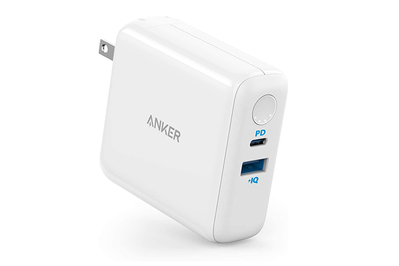
Anker PowerCore III Fusion 5K
The best power bank that doubles as a wall charger
This palm-sized power bank charges your devices on a USB-A port and a speedy USB-C PD port, and recharges itself via the USB-C PD port or through a fold-out AC plug.
Buying Options
$42 from Walmart
May be out of stock
*At the time of publishing, the price was $40.
Why you should trust me
As the writer of this guide, I spent 21 hours researching and 55 hours testing USB power banks and portable chargers. I’ve been a science journalist for nearly a decade, covering a wide variety of topics from particle physics to satellite remote sensing. Since joining Wirecutter in 2017, I’ve reported on surge protectors, USB-C cables and adapters, portable power stations, and more.
Who this is for
Most people could use a USB power bank (also called an external battery pack, backup battery, or portable charger) to keep phones and other devices charged while on the go. The question is, which one best fits into your habits? Some might need only a small battery to give their phone a boost at the end of the day, while those who travel a lot may be looking to power multiple devices over the course of several days. Rather than always having to track down a wall outlet wherever you go, owning a USB power bank allows you to enjoy a conveniently portable (albeit limited) power supply.
Even if you’re blessed with an abundance of charging options in your daily life—maybe you spend most of your day at home, at the office, or in the car—you could probably still benefit from a portable power bank. Something wallet-sized is great to always have on hand for those unexpected (yet critical) moments when your phone is dying and no outlets are nearby. But if you want something for weekend trips or a regular commute, slightly larger power banks can still fit easily in laptop bags, purses, or large pockets, offering two or more full charges for most smartphones. These power banks are robust yet portable, allowing you to also charge devices such as wireless headphones, computer mice, keyboards, vaporizers, digital cameras, and more.
When you’re traveling in an unfamiliar place—relying on your phone to guide you and to potentially call for help—a power bank offers added peace of mind. Strategically placing a few of these around the house isn’t a bad idea either: You can keep one in your foyer to grab as you’re running out the door, or one near the couch for when you’re curled up cozily under a blanket and really, really don’t want to get up to plug in your phone.
How we picked
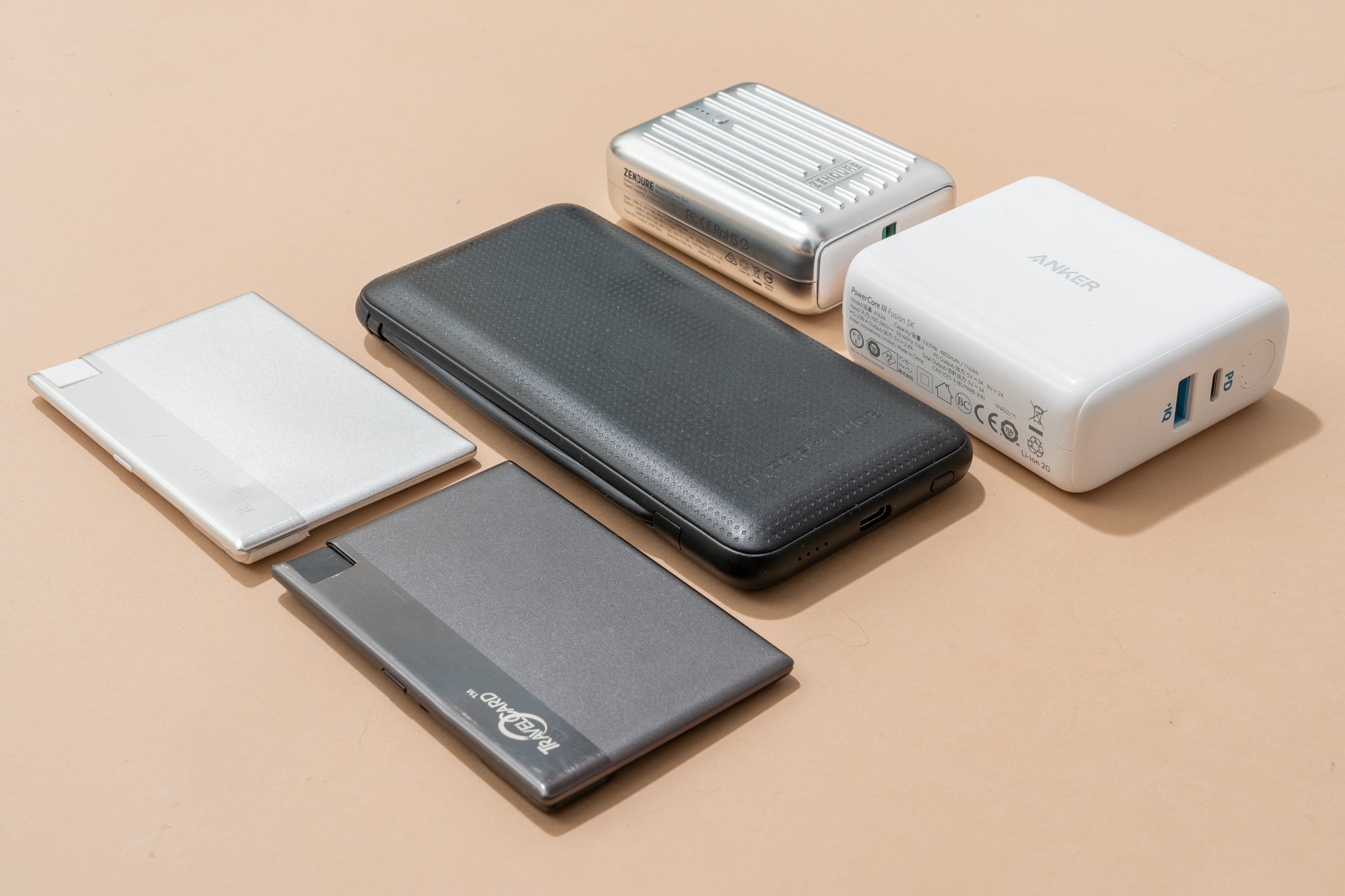
Due to the unfortunate fact that battery technology has failed to keep up with the processing power of modern devices, USB power banks have become an increasingly popular way to help phones and tablets get through the day. With tons of brands and models to choose from, we checked out major retailers like Amazon, Home Depot, and Target—as well as trusted editorial sources such as CNET, PCMag, PCWorld, and TechRadar—to find the most well-known makers of widely available USB power banks. From there, we built out a list of contenders based on the following features:
- Powerful charging and recharging: For models with USB-C output or input, we preferred those rated for at least 15 watts. That’s the minimum wattage needed for full USB-C charging and recharging speeds (though devices that support the even faster USB-C standard—USB Power Delivery, or USB PD—need at least 18 watts). Likewise, for models with USB-A output or Micro-USB input, we looked for those rated for 8 watts or more. Anything less powerful would be painfully slow.
- No heavier than half a pound: Power banks should be small and lightweight, making them easy to tote around in a wallet, pocket, or bag for an entire day. We preferred to test power banks weighing 8 ounces or less, since we don’t think most people want to carry something in their pocket or purse that weighs much more than a smartphone (for reference, an iPhone 13 weighs 6.1 ounces and a Pixel 5a weighs 6.5 ounces).
- Capacity rating of 1,000 to 10,000 mAh: The capacity rating listed on the power bank tells you roughly how much power it can hold. For reference, an iPhone 13 battery has a capacity of a little more than 12 watt-hours (about 3,300 milliampere hours), and a 16-inch MacBook Pro battery has a capacity of 100 watt-hours (about 28,000 mAh). Power banks with a capacity rating of more than 10,000 mAh tend to be bigger, heavier, and more expensive, so for this guide we focused primarily on lower-capacity power banks—those that store enough capacity to give your phone a boost of power or to fully charge it several times without weighing you down. Our favorite power banks for laptops with USB-C or AC charging have much higher capacity ratings than the chargers we recommend here.
- At least a one-year warranty: A year is plenty of time to use your power bank and make sure it’s working properly, although longer warranties are, of course, always preferable.
- Brand reputation: We favored brands that we’ve had mostly good experiences with in the past when it comes to responsive customer support, widespread availability, and capability to keep models in stock. We discounted models still undergoing a crowdfunding campaign, as well as brands lacking a visible web presence.
- Price: We used a ratio of capacity (mAh) per dollar to break ties between otherwise similar models.
- Built-in cables: We preferred power banks with some type of built-in cable or plug. This type of feature is indispensable when executed well, since separate charging cables (even if they’re neatly coiled up) take up more space in a bag.
This process left us with the following 23 power banks to test:
- Anker PowerCore 10000 PD Redux
- Anker PowerCore Fusion 5000
- Anker PowerCore Fusion 10000
- Anker PowerCore III Fusion 5K
- Anker PowerCore Slim 10000 PD
- Clutch V2 (Lightning) (discontinued)
- Clutch V2 (USB-C) (discontinued)
- Flux 4000 mAh Ultraslim Portable Charger
- HyperJuice 18W USB-C + Lightning Battery Pack (discontinued)
- HyperJuice 18W USB-C + Lightning Battery Pack (discontinued)
- Mophie Powerstation Hub
- Mophie Powerstation PD
- Mophie Powerstation Plus (USB-C)
- Mophie Powerstation Plus Mini (discontinued)
- Mophie Powerstation Plus Mini (USB-C)
- RAVPower 10000mAh Power Bank (RP-PB186)
- Real Graphene G-Lite (discontinued)
- TG90° Portable Charger 6000mAh External Battery Pack
- TravelCard Charger (discontinued)
- Tronsmart Trim 10000mAh USB-C Power Bank
- Zendure SuperMini 20W
- ZMI PowerPack 10K USB-C Power Bank (QB910)
- ZMI PowerPack Ambi 10K Dual USB-C Power Bank (discontinued)
How we tested
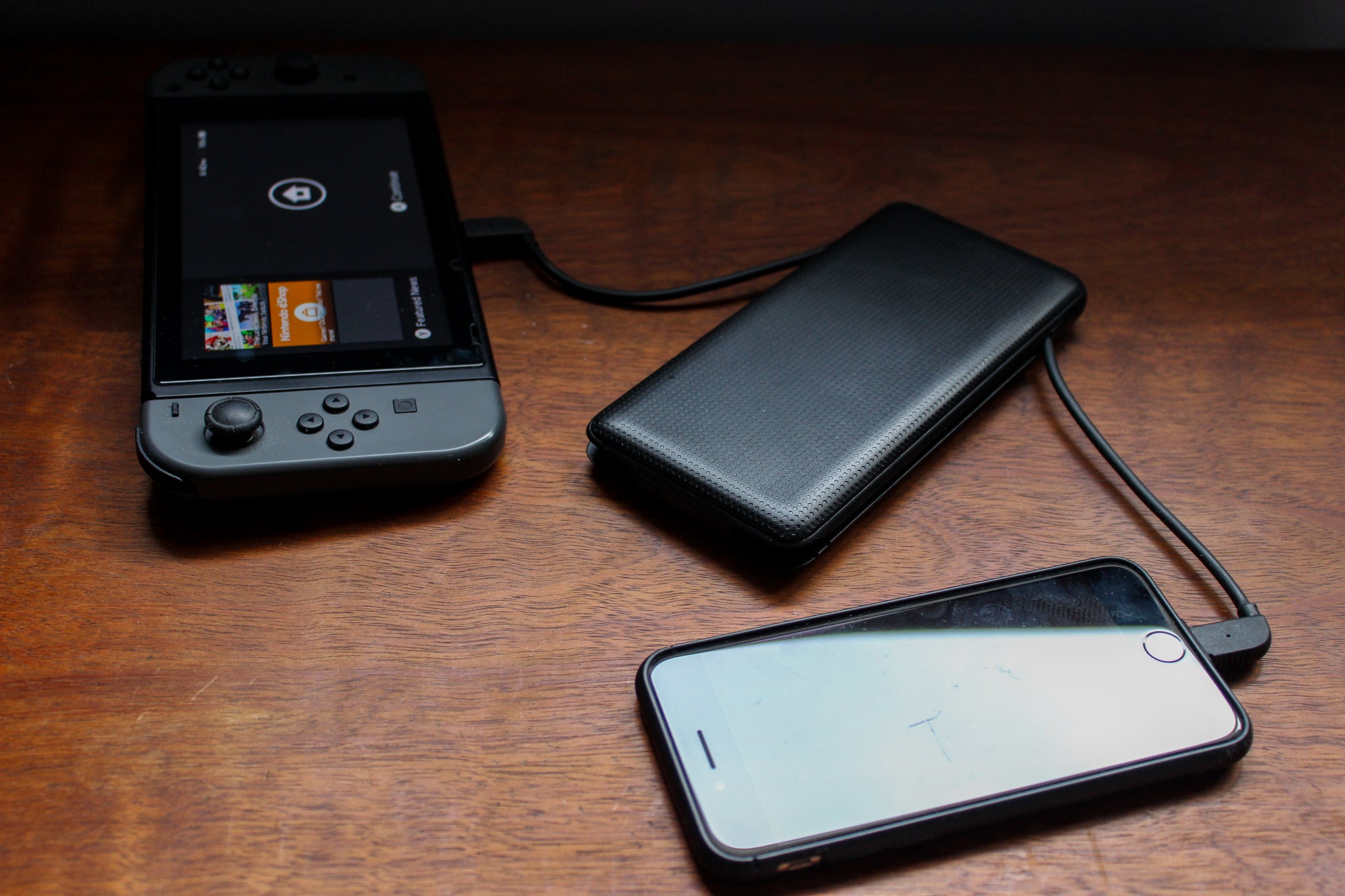
We tested the performance of each power bank in a few key areas, including the following:
- Weight: We used an Escali Primo Digital Scale to confirm the advertised weight of each power bank.
- Size: Rather than measure the length, width, and depth of each power bank—which would have been tedious, and not terribly meaningful for most people—we considered size in terms of whether a power bank fit inside a wallet, a pocket (we tried a variety of pants, skirt, and jacket pockets), or an accessories pouch.
- Look and feel: We took note of each power bank’s bulk and exterior texture. We considered how easy and intuitive its features—such as the power buttons, charging-status lights, built-in cables, fold-out AC plug, or flashlight—were to use.
- Charging output of USB-A ports: We measured USB-A output by connecting a half-charged power bank to a PortaPow and a Drok USB load tester. We then turned up the amperage of the load tester as far as it could go without overloading the power bank and recorded the volts and amps we measured with the PortaPow to calculate the maximum output (watts).
- Charging output of USB-C ports: We measured USB-C output by connecting a half-charged power bank to a Total Phase USB Power Delivery Analyzer, an Apple USB-C cable, and a MacBook Pro. We then used Total Phase’s Data Center Software, checked over the power profile and any errors, and recorded the volts and amps (to calculate the result in watts).
- USB-C recharging speed: We measured USB-C input by connecting a fully drained power bank to the Total Phase USB Power Delivery Analyzer and a 60 W MacBook Pro charger. We then ran Total Phase’s Data Center Software, checked over the power profile and any errors, and recorded the volts and amps (to calculate the input in watts).
- Micro-USB recharging speed: We measured Micro-USB input by connecting a fully drained power bank to a PortaPow USB Power Monitor, an Anker PowerLine Micro-USB cable, and an Anker PowerPort II wall charger plugged into a wall outlet. We then recorded the volts and amps we measured with the PortaPow to calculate the input (watts).
- Nintendo Switch compatibility: Because this popular gaming console is notoriously finicky when it comes to charging, we plugged each of the power banks into a half-charged Switch to make sure they could charge it at least partially. All of our picks passed this test.
Our pick: Zendure SuperMini 20W
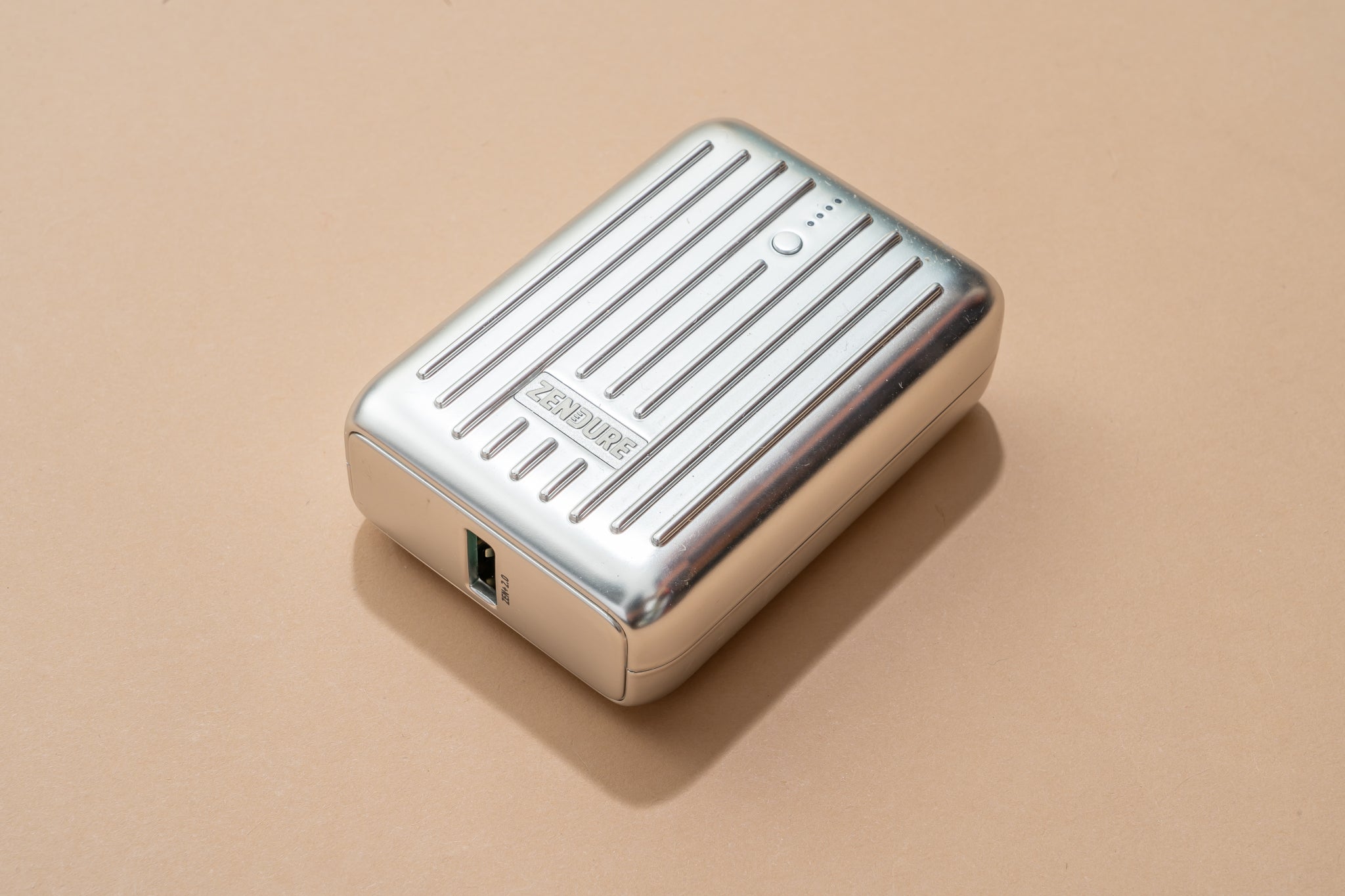
Our pick

Zendure SuperMini 20W
The best power bank for phones, tablets, and more
This is the smallest and lightest 10,000 mAh power bank we’ve tested. It has USB-C PD and USB-A ports, it comes in several colors, and its rounded edges make it easy to slip into a pocket.
The Zendure SuperMini 20W is the total package when it comes to charging a smartphone or other small electronic device while on the go. It’s compact and lightweight—around the size of a deck of cards and as heavy as an iPhone 13—yet its capacity rating is as high as any of our other picks. If you want a power bank that you can easily slip into a pocket or purse as you walk out the door but that still contains enough juice to charge most smartphones up to three times, this is the one to get.
The Zendure has a port on each end: a USB-C PD port on one side that works for both output and input (meaning it’s how you recharge the power bank itself), and a standard output-only USB-A port on the other. In our tests, we measured a maximum output of 18.6 watts and a maximum input of 19.3 watts from the USB-C port, and a maximum output of 16.6 watts from the USB-A port. While those numbers fall a little short of its 20 W output rating, the SuperMini is still powerful enough to charge most devices at top speed from either port, or to charge two devices simultaneously at slightly slower speeds. With a capacity rating of 10,000 mAh, you can fully charge your phone up to three times (or make instant friends by topping off strangers’ phones, as well—the “bumming a cigarette” of the digital age).
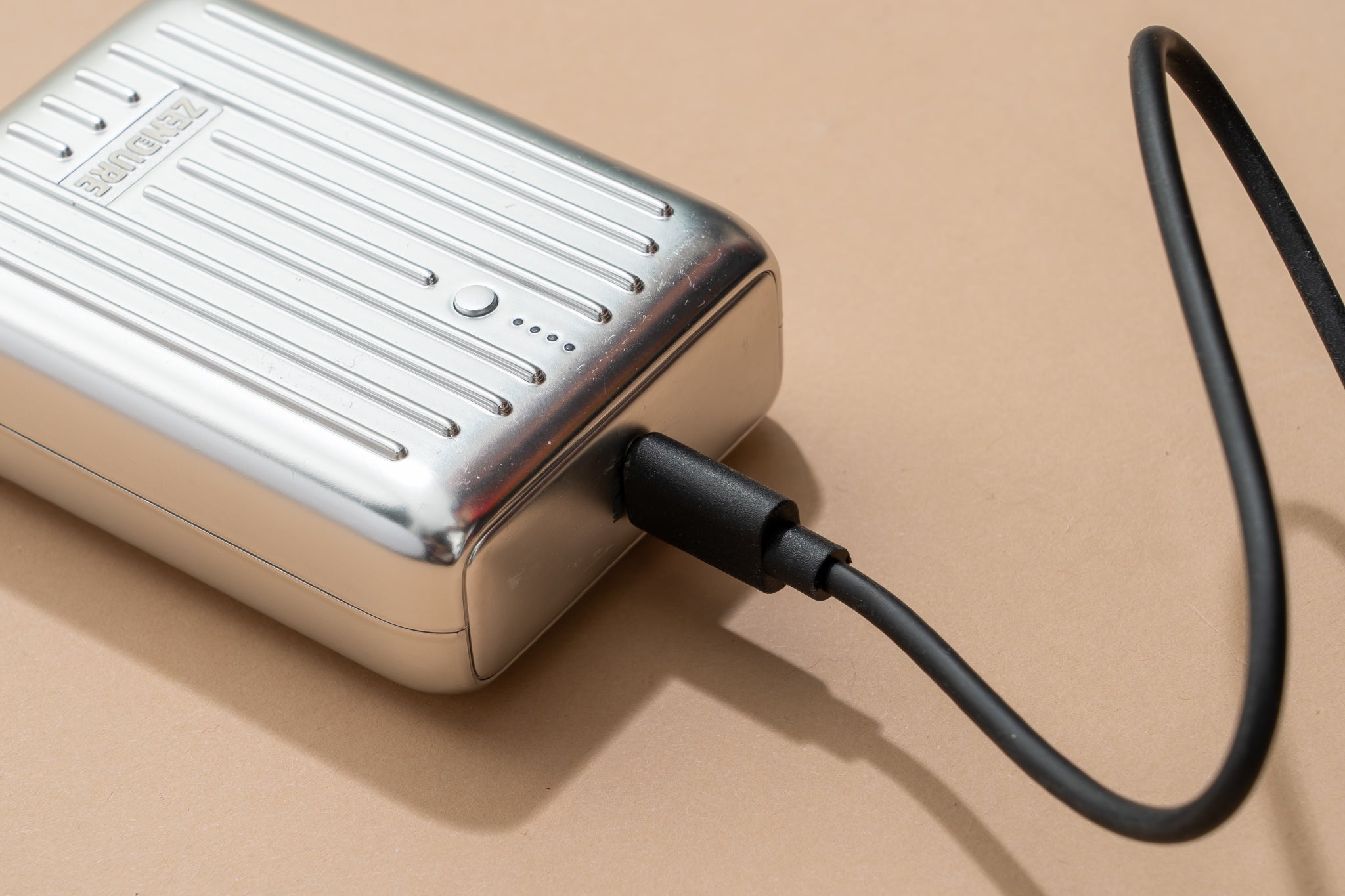
The exterior of the Zendure is a hard, shiny, plastic shell that’s relatively resistant to scuffs and scratches. It comes in a variety of colors (red, green, black, silver, blue, and pink) and, measuring just 3.1 by 2.2 by 1 inches, fits in the palm of your hand. It weighs 6.4 ounces—about as much as a hockey puck, which is lighter than any other 10,000 mAh power bank we tested.
The SuperMini unit is backed by Zendure’s two-year warranty—longer than that of any of our other picks—which should give you plenty of time to test it out and ensure you don’t have a dud. We’ve also had good experiences with Zendure’s customer support in the more than five years we’ve been reviewing its products.
Flaws but not dealbreakers
A major drawback of the SuperMini is its lack of built-in cables. We prefer having built-in cables to charge our devices over supplying and transporting our own—they take up extra space, get tangled, and are easily misplaced. And unlike our other picks, which can recharge via built-in cables or plugs, the SuperMini needs a separate cable (one is included in the box) to recharge itself. But we think the fact that it packs so much power into a miniscule package outweighs the small burden of having to pack a separate charging cable or two. It also means the SuperMini can charge a wider variety of devices, especially older ones that don’t use the latest connectors.
We don’t love the raised ridges on the SuperMini’s main surfaces, which make it look like a tiny hardshell suitcase, but that’s a cosmetic quibble. Plus, these protuberances make the power bank easier to identify by feel among the other contents of a purse or tote. They also add some extra grippiness compared with other models we’ve tested that have completely smooth exteriors.
Also great: Anker PowerCore III Fusion 5K
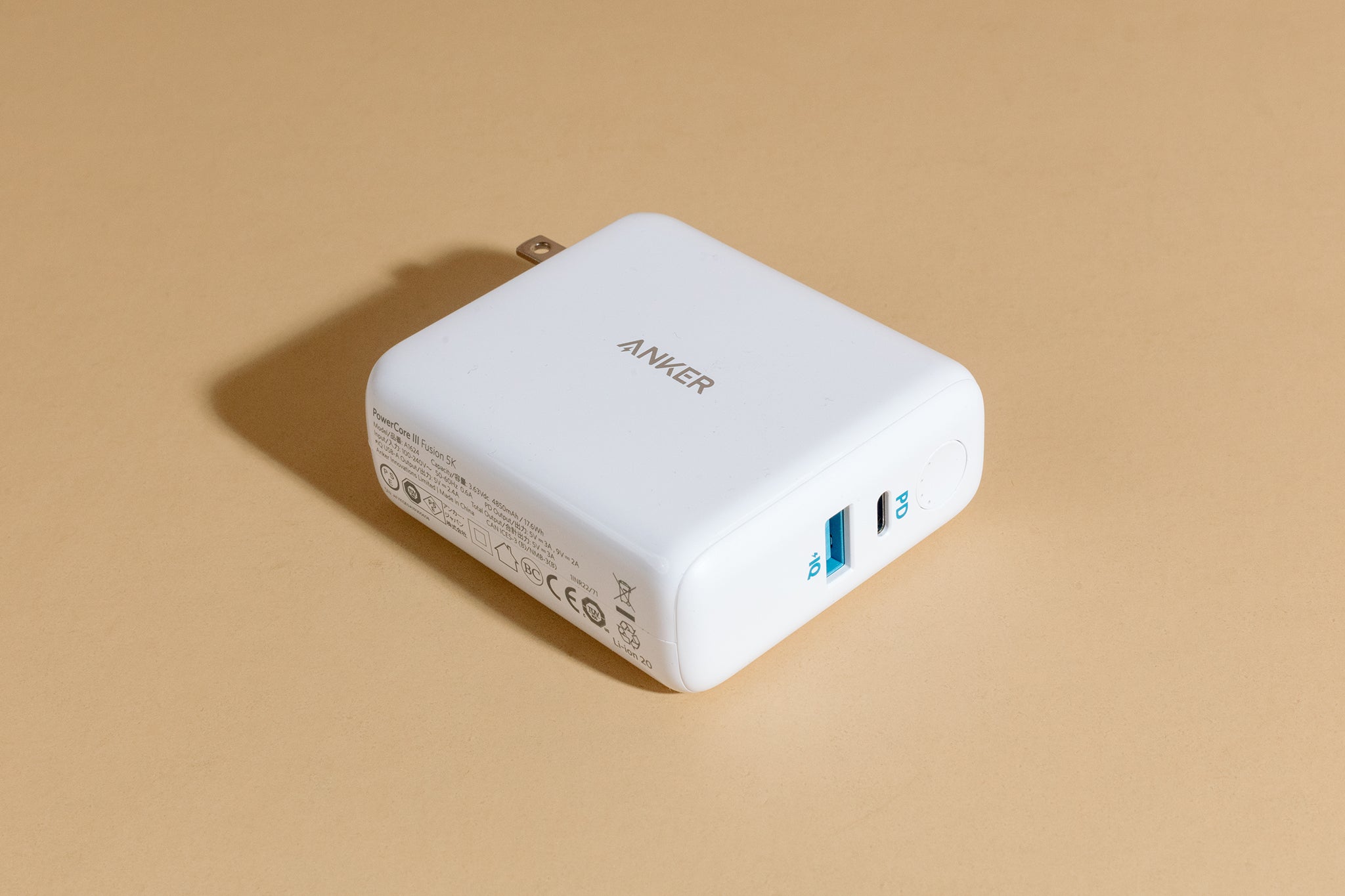
Also great

Anker PowerCore III Fusion 5K
The best power bank that doubles as a wall charger
This palm-sized power bank charges your devices on a USB-A port and a speedy USB-C PD port, and recharges itself via the USB-C PD port or through a fold-out AC plug.
$42 from Walmart
May be out of stock
*At the time of publishing, the price was $40.
The Anker PowerCore III Fusion 5K is the best power bank we’ve found that’s also a good wall charger. Rather than having a wall charger that you leave at home and a separate power bank that you carry with you, you can rely on a single gadget that does double duty. Plus, it’s easy to use: Flip open the AC plug and stick it in a wall outlet; wait for the four little battery-status lights on the front to light up, indicating that it’s fully charged; and then take it with you for hours of on-the-go power. And you don’t have to worry if your power bank dies while you’re out and about, because you can charge it on any wall outlet (or, using a separate cable, with any USB-C port).
The Fusion 5K is a relatively small charger—about the size of a tape measure, and even lighter at 6.4 ounces—making it easy to store in an accessories pouch or a roomy pocket. Its rated capacity (5,000 mAh) is enough for nearly two full iPhone 13 charges). Each of the Fusion 5K’s two USB-A output ports can send plenty of power to your devices, charging them faster than any other USB-A port we tested: We measured 13.5 watts when it was plugged into a wall outlet and 12.5 watts when unplugged—either way, it can charge your phone a lot faster than Apple’s standard 5-watt charging brick.
You can recharge the Fusion 5K via either the AC input plug (which sends 10.9 watts of power to the unit from a wall outlet, according to the test we ran with a Kill A Watt Electricity Usage Monitor) or the 18-watt USB-C PD input port, which is convenient if you need to recharge it from a laptop or some other USB-C power source. Given the Fusion 5K’s rated capacity, that means it should take a little more than 90 minutes to charge itself over AC, or just an hour over USB-C PD.
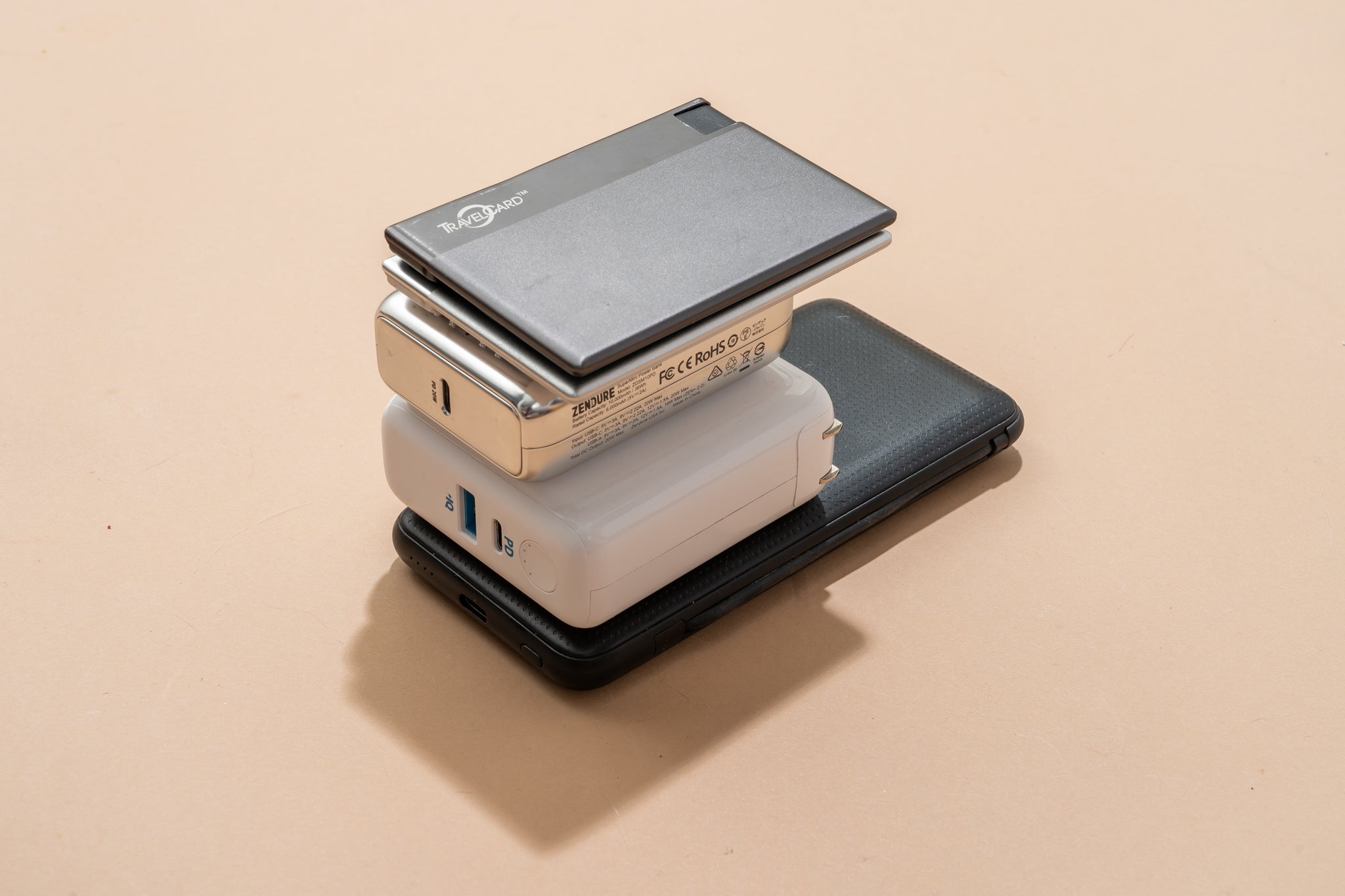
A drawback of the Fusion 5K is that it’s slightly less portable than our other picks—its chunky, squarish shape makes it harder to slip into an average-size pocket—and, like our top pick, the lack of built-in cables requires you to pack an extra cable or two to charge your devices. As far as two-in-one power banks go, though, it’s still fairly compact.
Other good power banks
If the Zendure SuperMini 20W is unavailable and you want the next-best-thing in terms of capacity and portability:
Get either the Anker PowerCore 10000 PD Redux or the Anker PowerCore Slim 10000 PD (depending on the price and which shape and color you prefer). Both models are rated for the same capacity as the SuperMini (10,000 mAh) and they’re about as pocketable, though ever-so-slightly larger. While the SuperMini weighs 6.4 ounces, the Redux weighs 6.8 ounces and the Slim weighs 7.4 ounces. Like the SuperMini, both models have a USB-C PD port capable of charging a smartphone or other handheld device (and recharging themselves) at top speed, as well as a USB-A output port.
If you prefer an upholstered exterior over the hard, plastic finishes of our picks, and you don’t mind sacrificing some power:
Get the ZMI PowerPack 10K USB-C Power Bank (QB910). Like the three aforementioned chargers, the ZMI has a 10,000 mAh capacity rating and ergonomically rounded edges. It weighs 7.4 ounces, or about as much as an iPhone 13 Pro. It fell a bit short in our maximum-output testing, managing just 16 W from its USB-C PD port, though we measured an impressive 15.6 W from its USB-A port. In terms of input, we measured 16.9 W over USB-C PD and a measly 4 W over Micro-USB. The ZMI comes with a USB-C charging cable and a cloth bag (the SuperMini, Redux, and Slim do, too), and adds a handy two-in one cable (a Micro-USB cable with a USB-C adapter attached to the end by a short tether). Compared to most other fabric-covered gadgets we’ve tested, this one uses a more stylish and sophisticated-looking textile—a soft, tightly woven, marled-gray twill. It’s fairly durable, though not impervious to stains.
If you want a power bank that doubles as a wall charger and has twice the capacity of the Anker PowerCore III Fusion 5K, and you don’t mind spending a bit more on a bulkier model:
Get the Anker PowerCore Fusion 10000. It has the same easily pocketable shape, fold-up plug, and convenient battery-status lights that we prize in the Fusion III. Plus, it’s rated for 10,000 mAh, has a pleasantly grippy and comfy-to-hold matte finish, and comes in three colors (black, white, and red). We didn’t make it an official pick because it’s significantly bigger and heavier than our other recommendations, weighing a whopping 9.6 ounces (like our top pick, the Fusion III weighs just 6.4 ounces). But if you want more capacity and can live with the extra bulk, this is your best bet.
Sustainability and power banks
Power banks are made primarily of plastic, metal, and other nonrenewable materials that take decades to decompose. As such, one of the most sustainable things you can do with a power bank is to avoid replacing it for as long as possible. Handle your power bank with care to prevent scratches, scuffs, and dents, and store it in a protective pouch or cable organizer when it’s in your bag. Since extreme temperatures can permanently damage batteries, you should also try to store your power bank in a cool, dry place (preferably at about a 40% charge).
If your power bank does break, iFixIt and Instructables have handy guides to mending most types of electronics. But if it’s damaged beyond repair or no longer holds a charge, you should recycle it. Most Americans recycle plastic, metal, paper, and cardboard on a regular basis, but less than half (subscription required) recycle their used batteries and other electronic waste (also called e-waste). Unrecycled e-waste usually ends up in a landfill, where it can leach heavy metals and other harmful chemicals into local soil and water systems. It also contributes to more raw materials being mined to make new electronics, rather than salvaging usable components from old ones.
Here are some good options for recycling power banks and other e-waste:
- Find e-waste recycling facilities in your area using searchable databases like Call2Recycle, Earth911, GreenCitizen, or Greener Gadgets. Most municipalities don’t offer curbside pickup for battery recycling, but many have designated dropoff sites. Before dropping off batteries at a recycling facility, make sure it accepts lithium-ion batteries (the type found in most power banks, including the picks in this guide, as well as many other household electronics) as they may require different safety precautions than other battery types.
- Keep an eye out for local e-waste recycling drives—or try organizing one yourself!
- Mail in a prepaid shipping container from TerraCycle, Call2Recycle, or another recycle-by-mail service.
The competition
The Anker PowerCore Fusion 5000 is our former pick for people who want a power bank that doubles as a wall charger. It has the same capacity (5,000 mAh) as the Fusion III, as well as the same handy fold-up plug and pocketable size and shape. However, its ports (two USB-A output ports and a Micro-USB input port) are much less powerful than those on our current pick.
The Flux 4000 mAh Ultraslim Portable Charger is lightweight (3.1 ounces) and small enough to fit in a pants pocket. It has a Micro-USB input port, a USB-A output port, and built-in USB-C and Lightning cables, and comes in a variety of colors. However, the cables are nearly impossible to get back into their slots after charging and the materials seem flimsy overall.
The intelliArmor Scout Max is a jack of all trades, master of none. It has a built-in AC plug and Micro-USB port to charge itself, and its built-in Lightning, Micro-USB, and USB-C cables can charge pretty much any handheld device. But unsheathing the cables and plug is trickier than we’d like, and its 10,000 mAh capacity is no better than that of several of our picks. Plus, we couldn’t find any warranty information on the company’s site and can’t vouch for its customer support.
Although the Mophie Powerstation Hub has a bit more capacity (6,000 mAh) than the Fusion III and adds Qi wireless charging, we don’t think those features justify the usual $100 price tag. Plus, it has a more angular shape that’s not as comfortable to hold or as easy to slip into a pocket.
The Mophie Powerstation PD is super lightweight, weighing just 5.2 ounces, and has a pleasantly pocketable shape and grippy texture. However, it offers significantly less capacity (6,700 mAh) than our SuperMini pick, which is just a few ounces heavier.
The Mophie Powerstation Plus (USB-C) and Mophie Powerstation Plus Mini (USB-C) are sleek-looking and lightweight. But the built-in USB-C cables are especially tricky to get back into their slots, which we think would drive most people up the wall.
The RAVPower 10000mAh Power Bank (RP-PB186) is nearly identical to the Anker Redux, except for the rough ridges at each of its seams that make it less comfortable to hold. But if you can get it for significantly less money than the Anker model, it would be a great alternative.
The TG90° Portable Charger 6000mAh External Battery Pack is one of the smallest and lightest power banks we’ve tested, weighing just 4.1 ounces, and its capacity rating (6,000 mAh) is higher than our Anker pick. As a major added convenience, it has two built-in cables (USB-C and Lightning) that slide in and out of their holsters easily, as well as a USB-C input port. It’s also relatively sturdy and well built. Despite these attributes, however, we don’t feel comfortable recommending this model without long-term testing; aside from its Amazon storefront, the company has no web presence.
The Tronsmart Trim 10000mAh USB-C Power Bank has the same capacity rating (10,000 mAh) as our SuperMini pick, plus it adds a Micro-USB input port. However, we don’t think an extra (and slower-charging) input option offers a significant benefit for most people, and we prefer the look and feel of our picks.




















+ There are no comments
Add yours